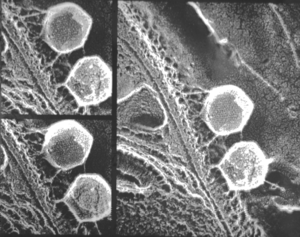Phycodnaviridae: Difference between revisions
No edit summary |
No edit summary |
||
| Line 9: | Line 9: | ||
===Genera=== | ===Genera=== | ||
'' | ''Chlorovirus'', ''Coccolithovirus'', ''Phaeovirus'', ''Prasinovirus'', ''Prymnesiovirus'', ''Raphidovirus'' | ||
==Description and Significance== | ==Description and Significance== | ||
Revision as of 15:21, 12 July 2006

Baltimore Classification
Higher order taxa
Viruses; dsDNA viruses, no RNA stage; Phycodnaviridae
Genera
Chlorovirus, Coccolithovirus, Phaeovirus, Prasinovirus, Prymnesiovirus, Raphidovirus
Description and Significance
Phycodnaviridae are viruses with double-stranded DNA that infect chlorella, algal symbionts of paramecia and hydras. Members and prospective members of the family are large icosahedral viruses that infect eukaryotic algae.
Genome Structure
The genome of phycodnaviridae is not segmented and contains a single molecule of linear double-stranded DNA. The complete genome is 250000-350000 nucleotides long. The genome guanine + cytosine content is 40-52 %. The genome contains unusual bases, varying from 0.1-47 %. These bases are 5-methyl deoxy-cytosine residues and N6-methyl deoxy-adenosine residues in some DNAs. The double-stranded DNA is non-permuted and the genome sequence has termini with cross-linked hairpin ends. The genome, except for the hairpin, has terminally redundant sequences. These sequences have inverted terminal repetitions (ITR) for at least 2000 bases. (source: ICTVdB Descriptions)
The virions of phycodnaviridae consist of a non-enveloped capsid. The virion attaches to the host cell surface and releases DNA into the host cell in a similar fashion as Tectiviridae. The capsid is round and exhibits polyhedral symmetry. The isometric capsid has a diameter of 130-200 nm. The capsid shells of virions are composed of multiple layers and are referred to as multilaminated capsids. The capsids appear hexagonal in outline. (source: ICTVdB Descriptions)
Viral Ecology & Pathology
References
Van Etten, J.L., Graves, M.V., Mueller, D.G., Boland, W., and Delaroque, N.; "Phycodnaviridae - large DNA algal viruses"; Archives in Virology, 147; 2002
